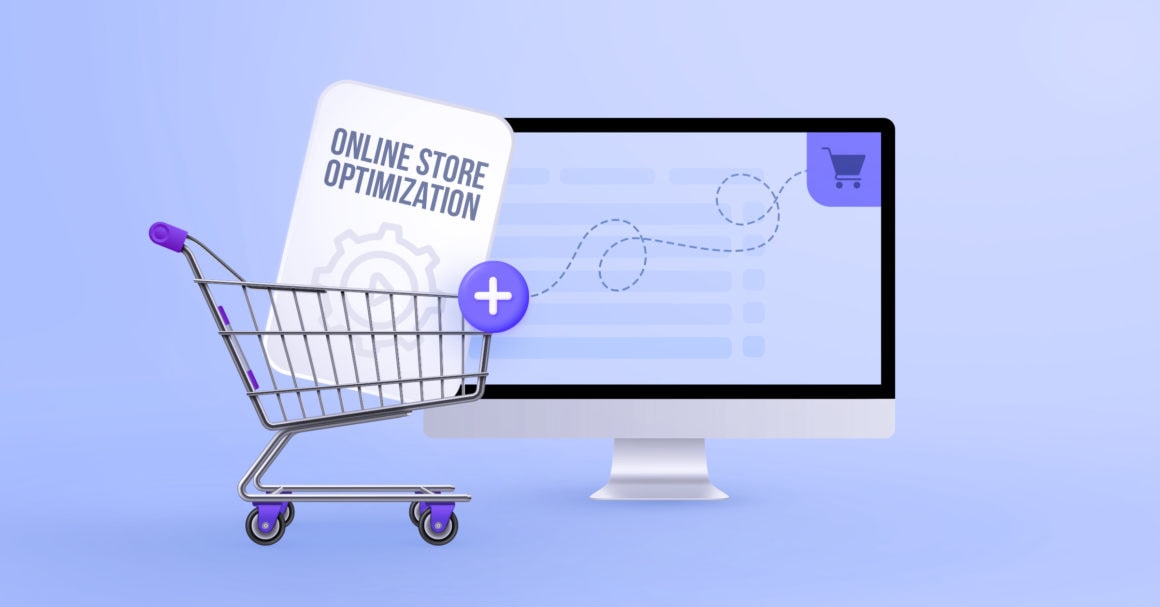You know brick-and-mortar stores feel threatened when they market themselves as having prices as good as online stores.
Online shopping has become synonymous with good deals, savings, getting the best price, and so on. And right now, everyone has an online presence. If you can’t beat them, join them, I guess.
Ecommerce stores are a powerful force that are reshaping the way we get stuff we need for entertainment or just plain survival. If there was one thing that should be salvaged from the Internet if it ever comes to a crash – it would not be people’s ability to put their ideas out there without any verification and consideration nor the endless supply of memes – it would be the almost transformative experience of being able to get your hands on virtually any item for a good price and having it delivered right to your doorstep.
Isn’t that the contemporary incarnation of a wishing well?
Apart from the part where you have to pay for the product.
Ecommerce stores allow anybody, from a small craftsman, reseller or dropshipper to a big corporation, to reach out to global audiences to fulfill their needs in a most convenient way. This is the revolution no one seems to be talking about. To want an item and get that item as fast as possible.
To achieve these wonders, ecommerce stores put a lot of thought into designing their shopping experience. There wouldn’t be any revolution without them implementing significant technological advancements, as well as various persuasive techniques that make people enjoy the whole process.
There is no online store that has successfully applied all these techniques.
Maybe with an exception of the biggest one – Amazon.
Most of the stores do some things right while skipping the other things. Moral of this? There’s always room for improvement.
The following article is dedicated for people that want to:
- Start their own ecommerce store
- Improve their store’s conversion rate
- Expand their store in a new market
It is meant to be a go-to place for any person that takes care of their own ecommerce store or has been hired to do so. Marketers, sellers, manufacturers and devs, let’s make the best possible version of your online store!
Ecommerce store optimization
Optimization is any effort to increase your overall profitability – in the end, it is all about getting more conversions. A conversion is any action that brings you profit. Optimizing your store allows you to get more conversions by:
- Increasing your store’s visibility online;
- Adjusting your pricing strategy;
- Streamlining your conversion funnel;
- Reducing bounce rate and shopping cart abandonment;
- Providing more effective copy (product descriptions and headlines) of your product;
- Creating appealing images and videos;
- Bundling your products in a smart way.
And many more. In the end, it is not about forcing your product down people’s throats. It is about presenting your merchandise in the most effective way and connecting with an audience that is the best match.
This article is divided into two parts:
- Advertising your store and your products
- Product and store
You can jump straight into the interesting part or go through the whole guide A-Z for the most complete dive.
Recommended tools for ecommerce store optimization
There is a wide selection of specialized programs designed to measure, tweak and add functionalities to your online business. Let’s take a quick look:
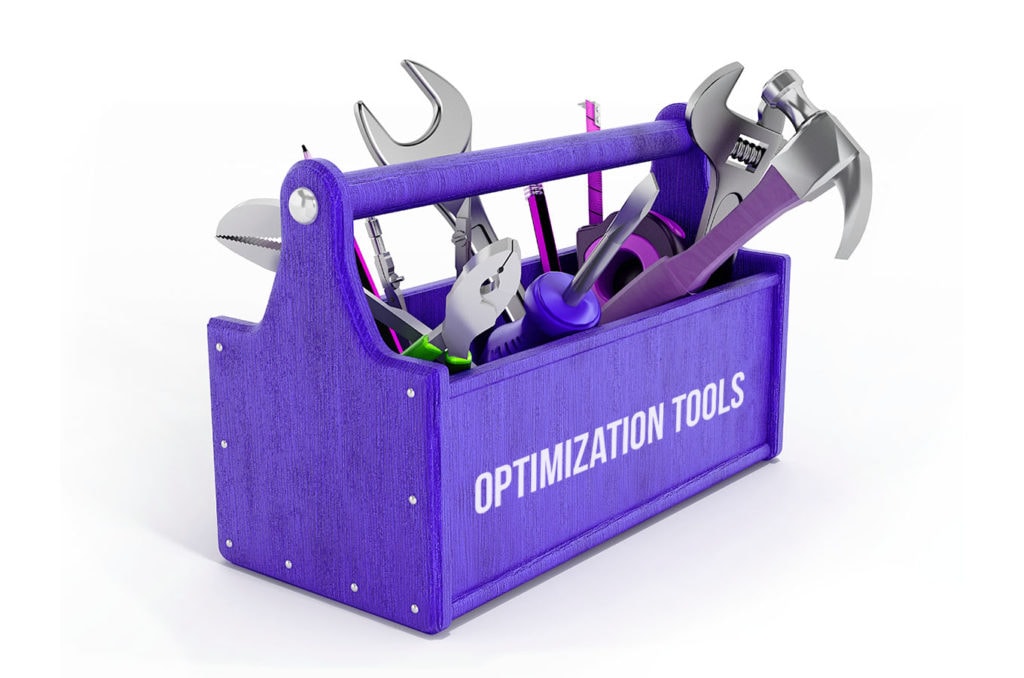
- Data analysis software. There’s a wide choice of tools that complement each other:
- Keyword and SEO tools. These tools can help you increase the volume of organic traffic.
- CRMs. They allow you to manage your customer data, like emails and phone numbers and reach specific groups with personalized messaging.
- Website builders and ecommerce platforms. You can go with platforms that were designed for creating ecommerce stores or build your own website from scratch.
- Payment gateways. They authorize online payments for your store using various methods.
- Site testers. They measure your website performance.
- Customer service software. This will help you manage any support tickets your customers may create.
Part one: Advertising your store and merchandise
This is the area that experiences the most developments ever. The overall trend is to blur the line between content and a store.
Do you like the shirt that your favorite YouTuber talking about popular science has? One click and it’s yours!
Same goes for your favorite Instagram model (we know you have one).
What about Twitter commentators? You can’t see what their shirt looks like? No problem, Twitter allows people to showcase their products at the top of the screen.
Shopping claws its way to every piece of content people consume online. Consider your presence there. But let’s start from the beginning.
Two ways of promoting your store
As you probably know, you can go either with a paid option and spend money to put your ads in various places or go with a free option. In the latter case, visitors discover your store and products organically, through a search engine, hence the name – organic traffic.
Like with so many things in life, reality lies somewhere in between the two, meaning that you will get the best effects by combining both methods. Each method offers unique opportunities of reaching new pools of potential customers. Explore, test, and never miss out on an opportunity to get new people.
Paid ecommerce advertising
In the paid model, you need to go to a platform that sells online space and purchase the parts that are of interest to you.
There are so many places you can go to:
Google Ads. The world’s best search engine provides plenty of options that work great for ecommerce stores. You may choose to appear in:
- Search results. Your promoted ads will blend with organic search results. What makes this great is that Google allows you to put a lot of additional information that makes contacting you easier. These include:
- Store physical address
- Opening hours
- Phone number
- Google shopping network. This is Google’s own marketplace that, on one hand, is not nearly popular enough as your regular go-to platforms but it allows people to put shoppable posts directly above search results.
- YouTube. You can go with a variety of ad formats that YouTube has to offer. The video format is popular, and parts or even whole video segments are obligatory to watch, which effectively kills banner blindness.
- Google Partner network. This is basically Google’s own ad network that allows you to put your ad on various sites.
Facebook Ads. The social media giant enables you to put ads of various types right where they fit best. Facebook offers plenty of free stock photos to quickly generate engaging ads. Or you can use your own creatives and utilize various ad types: from a standard image to video or carousel.
Both Google and Facebook allow for really precise targeting – this is the reason for them invading people’s privacy so much. You can target based on interest, previous shopping behavior and more.
Ad networks and DSPs. You can also go with a variety of ad networks which deal with different ad formats and have access to various publishers.
Ad networks usually don’t allow for such precise and low-level targeting. The CNN.com website doesn’t track you as much as you might think.
Optimize your paid advertising
Here are some tips that will let you squeeze the most out of your paid ads:
- Emphasize benefits of using the product rather than product features (“safety and peace of mind” rather than “256-bit encryption”). Hide details in technical specification subpages or sections.
- Use social proof. Allow customers to submit their own reviews and pictures. You can reward customers for submitting a review. People will trust a product more that has an overall rating of 4.2 stars coming from over 400 reviews than a product that has a 5-star rating with only two reviews.
- Use images, 360 views and videos. People shop with their eyes. Again, show people using your product (clothes, earphones), not only the product itself.
- Use language appropriate for your audience. Don’t be afraid to use a more edgy approach if you are sure that this will get you credit in the eyes of your prospect customers:
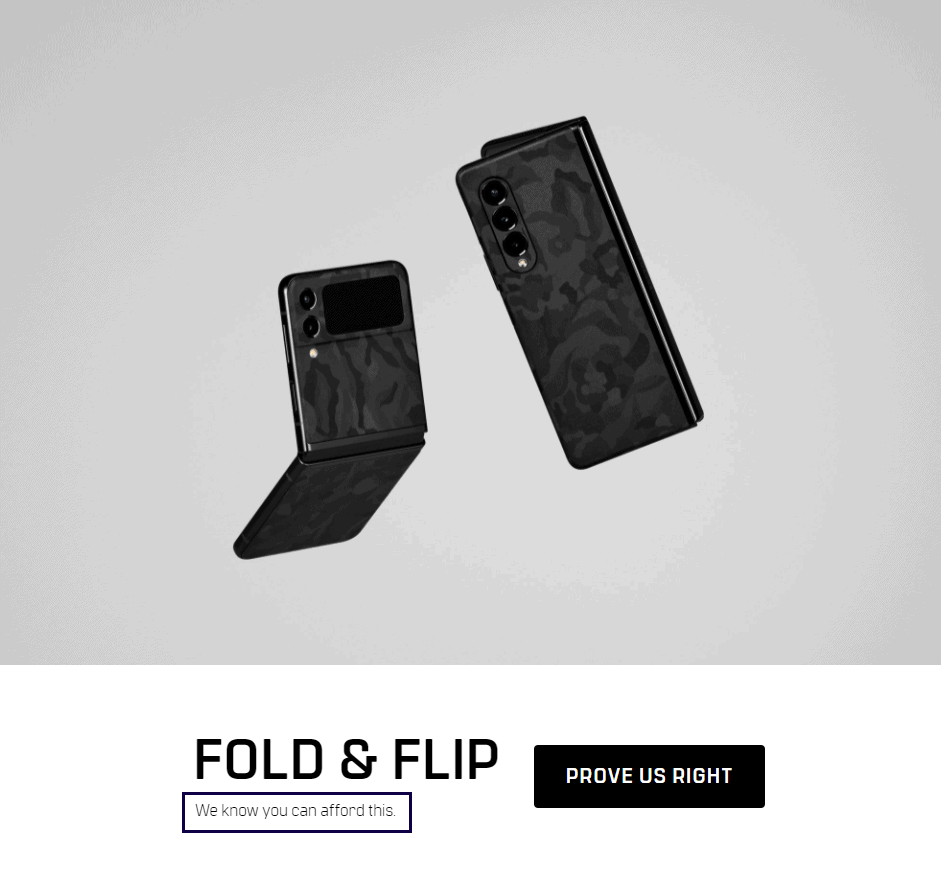
This is dbrand’s page that sells, among other things, phone accessories. They are well-known for their aggressive advertising.
Remarketing and retargeting
The two similar lead-nurturing techniques are a great way to take advantage of previously engaged audiences. Although these terms are sometimes used interchangeably, they mean slightly different things:
- Retargeting is targeting visitors with paid ads based on their previous engagement with your site, like a visit.
- Remarketing uses email to reach out to satisfied customers or those who have abandoned their shopping cart.
Organic ecommerce advertising
The free option is about making yourself discoverable. How?
Google and other search engines (yes, there are others) are always on the hunt for new and changed web pages. Their search engine tries to map the whole Internet. The key elements to this plan are programs called search bots that scan your and every other web page out there.
If you want to rank high in the search results, you have to design it in a way that makes the scanning process easier. Google wants to quickly know what your web page is about and what valuable elements you have.
The whole science behind figuring out what Google wants and adhering to those requirements is called SEO. This stands for Search Engine Optimization.
Ten years ago, SEO was almost synonymous with keyword stuffing.
Now, it’s a whole specialization that grows with each update of Google’s algorithm.
In short, there are two areas of SEO: on page and off page SEO. The first one refers to the design of your page while the second one refers to things you can do elsewhere and is usually tied to your backlink (so links that point to your page from other pages) strategy.
On-page SEO
There are many SEO techniques that each webmaster can apply. They refer to content pages and product pages. I won’t detail SEO strategy from end to end as there is simply too much to talk about with everything from adding a good meta description or using alt text for images.
Let’s focus on ecommerce-only SEO tips:
- Design your page in a way that enables bots to find information quickly. It’s better to write “Price: $300” instead of “You can get this beautiful item for merely three benjamins”. Use schema markups.
- Ecommerce stores tend to create a lot of pages with similar descriptions. Usually these are product pages that may differ only in one detail, like product color. Avoid this by keeping all product options available on one page (like Amazon does) and using canonical links to mark the main product page.
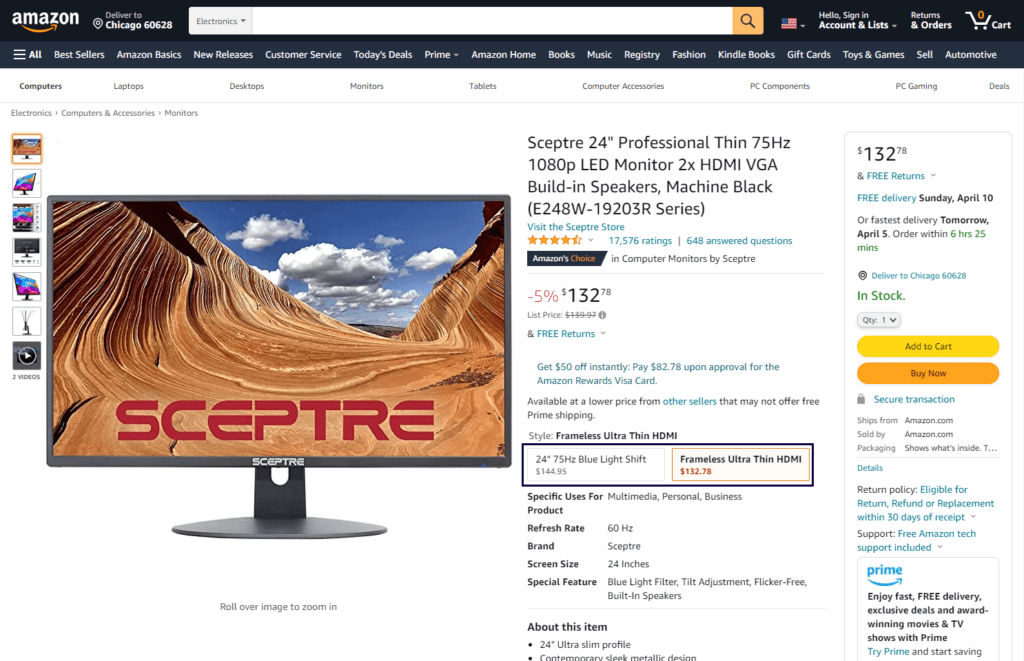
- Find good product-related keywords and design your content around them. Remember that you can only use brand words that you have rights to. A good strategy is to pay for your own brand keyword. Why pay for traffic when you can get it for free? To avoid situations where your competitions will pay for your brand keyword and a customer, after typing your brand into search engines will see an ad “10 best alternatives”.
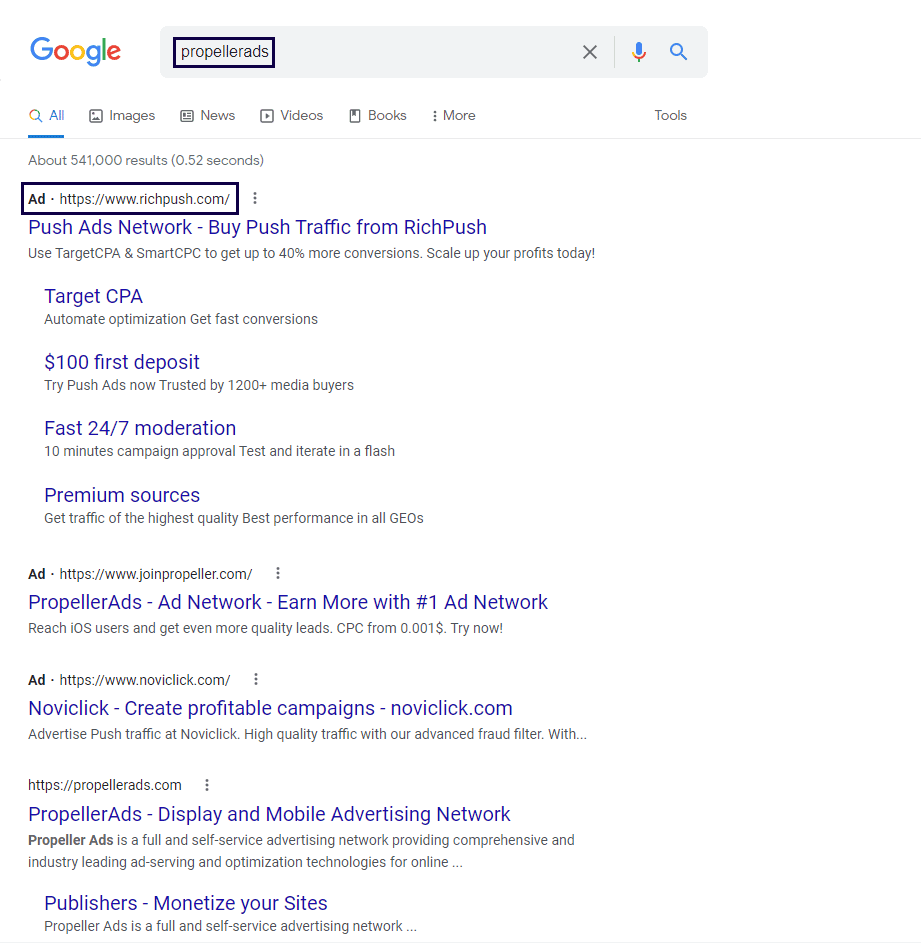
Part Two: Product and Store
The second thing you should focus on is your pricing strategy and how your product is presented against competitors.
Pricing is a delicate subject that is a derivative of multiple factors, many of them outside the control of a typical chief marketing officer. But sometimes getting to the lowest price possible is not as important as presenting your product’s benefits when compared to the competitors.
You don’t have to be the cheapest one to get a lot of sales.
Have you ever skipped purchasing an item because it was suspiciously cheap? Yeah, I also stopped buying on AliExpress.
Position your product
Know how you are advertising. Is it a price-sensitive group? People that like when products hit that price vs functionality ratio just right? Or maybe you are advertising to people that simply don’t care about pricing that much.
In all cases, tell people exactly what they are paying for. If your product is on the cheap side, advertise the ‘basic’ or ‘essential’ angle.
If your product is more costly and feature-rich – present these features.
Compare to other products from your lineup or to competitors. If possible, try to implement the option that allows users to compare different products with each other.
Allow to make informed decisions
Let’s talk about safety. More specifically, about U2F keys that are sold by Yubico.
(Side note: get one right now. This is not an ecommerce tip nor it is not an affiliate thing. U2F keys are awesome safety devices and everyone should have them).
Yubico sells a variety of U2F keys that are good for individual and professional use. There are different scenarios for using them and different devices that could benefit from them. One can easily feel lost making a good decision.
This is why Yubico introduces a handy key selector wizard that asks a visitor several questions and proposes the best fit for a given scenario.
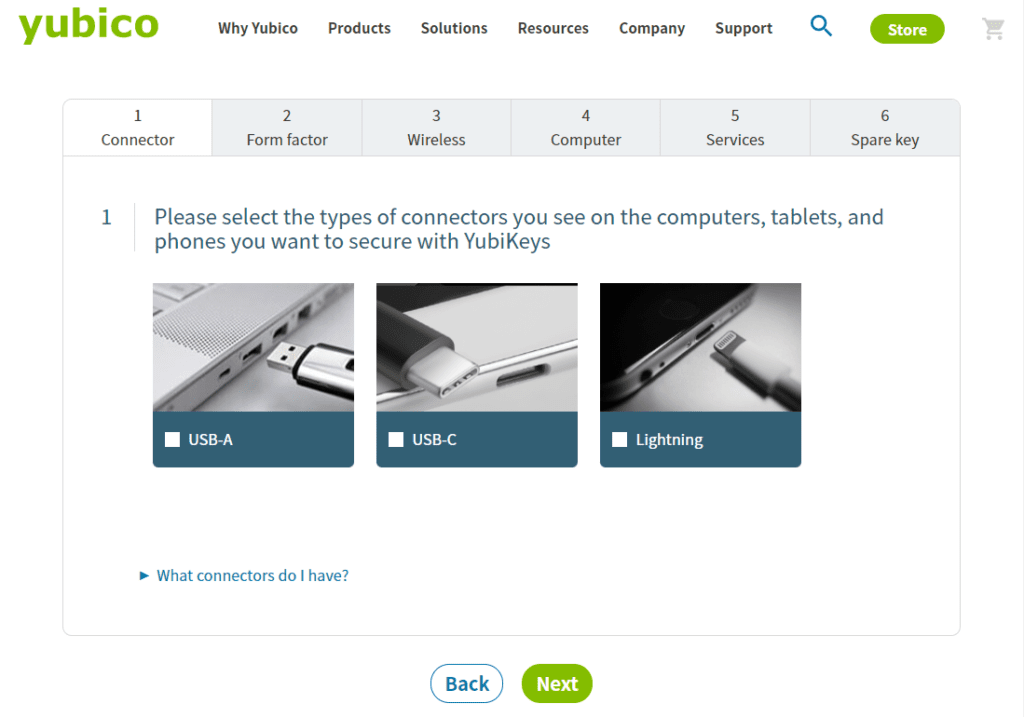
Honestly, this is the best example of supporting a customer along the way out there.
Design the shopping experience
Try to make your shop not about your products, but about solving visitors’ problems.
Imagine that you have a store with camping gear. You can advertise your tents as being cheap, versatile or durable. And advertise sleeping bags separately as being warm and lightweight.
But what if you just simply ask a visitor what they want to do:
- 3 day camping with family?
- 6 month-long excursion to the Andes?
Ask what their needs are and propose products that fit the use case. Ask additional questions:
- “Do you want to cook outdoors?”
- “Do you need food rations?”
- “You should think about a mosquito repellent”
Want more proof? Take a look at MSI’s, a computer manufacturer. This is their site:
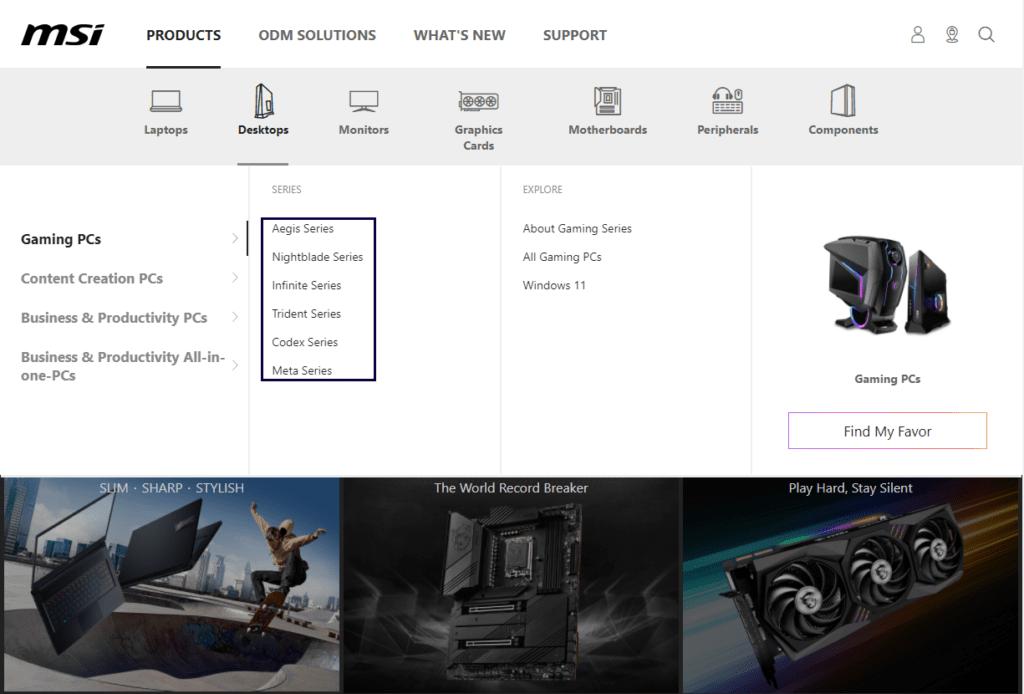
Imagine that you try to purchase a gaming PC. Do you know what to expect from their PC series names? Is the Aegis series better than the Nightblade series? Which one is more powerful, which one is cheaper? You would have to read about each series to know what to expect from them.
Now move to NZXT, another computer manufacturer. It offers a great tool that helps to design the PC of your dreams. Not a computer expert? Don’t worry, just set your desired frame rates of your favorite games and a resolution that you are aiming for and the tool will help you get components that deliver just that.
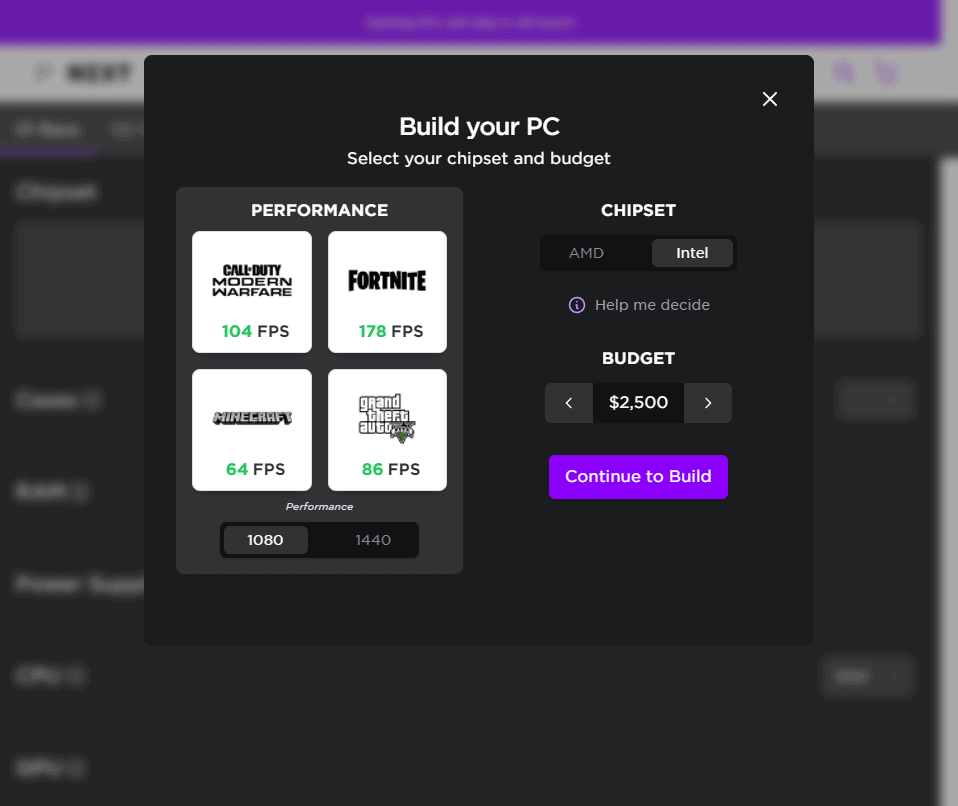
This is the problem-solution approach. NZXT’s products are here to help. They don’t require you to learn what’s behind the fancy names. They will surely allow you to hit the 120 fps mark in Call of Duty and be ahead of those console peasants.
If you have the budget for this.
Bundle products together
Offering product bundles is one of the oldest and most effective techniques. “Second item half price”, “Save on a bundle”, this messaging works great in both brick-and-mortar stores and online ones.
The difference is that with online stores you have so many additional options. You can:
- Calculate complex discounts for purchasing bigger quantities.
- Propose product bundles based on previous shopping behaviors. This is where “People also bought” or “Frequently bought together” categories come in.
Smooth conversion flow
The fewer steps required to make a purchase usually means more people that reach the end.
There are many sins that smaller ecommerce store owners especially commit. Here’s what to do to avoid them:
- Asking for too much information that is not necessary to the purchase.
Treat customers like precarious birds that are easy to scare off. Any unnecessary text field can make them bounce. Ask only for things that are absolutely essential for a successful delivery.
- Make submitting information as easy as possible.
- Use geo localization to help customers find the nearest store or package pickup point.
- Use address validation for delivery forms.
- Requiring users to sign up to make a purchase.
Forcing a customer to create an account may seem like a good method of tying them to your store – but this technique may have an adverse effect. Sometimes people want to just buy one thing and not think about your store ever again.
This is especially true for products that are used for special occasions only. How often do you shop for baptism gowns for toddlers? A customer probably doesn’t need to know about your weekly promotions.
- Enable guest checkout option.
- Allow customers to create an account during the purchase process and don’t ask users to fill personal information again after logging in.
- Providing a limited number of payout and delivery options.
Choice is freedom, money’s money, no matter if the money is in the form of prepaid Revolut cards, food stamps or grandma’s jewelry.
Multiple payment options are not only about convenience, they are also about safety. Customers know that a payment provider such as PayPal offers a strong customer protection mechanism and any store that uses such a provider automatically gains credibility.
- Offer various payment options, including BNPL (buy-now-pay-later) services
- Propose different delivery services, if you have the option. The number one reason people prefer online shopping is free delivery – you should consider offering that for your pricier products.
- Poor customer service.
There are few things that make people more angry than poor customer service. Maybe only a dumb sales bot is more infuriating. Studies show that people are willing to spend more in stores with good customer service.
- Tell people honestly about expected delivery days or product shortages.
- Inform customers about the working hours of your customer support and what is the best way to reach you.
5. Poor mobile experience
I’m not going to quote you any statistics on mobile device usage. You know this and you are probably reading this on your phone anyways. Make sure that the design of your store matches the mobile-first world.
- Design your store’s page to be mobile friendly and/or develop a mobile app for your store. Ecommerce store providers such as Shopify have mobile store builders, use them.
- Test your mobile page for speed and responsiveness. Such pages should be light, as they are often viewed using career data.
Father’s test
A good way of checking if your conversion flow is easy, is to ask your father to complete a purchase. A so-called ‘father’s test’ is meant to be used to assess how a less tech-savvy user (your father, partner, friend, etc.) can handle a task that, for us compulsive Internet users, is as easy as breathing.

A step-up from this is ‘grandma’s test’. You can figure out how this works on your own.
Part three: Data analysis
We’ve discussed various tips and ways to run your ecommerce store more efficiently. But to get the most accurate insight, you need to gather data, analyze and learn.
Not all tips work for every business and scale. Instead of searching for a magic bullet, it is better to make more data-driven decisions.
Data that you can gather can be of two sorts:
- Qualitative
- Customer feedback
- Pools
- Reviews
- Support tickets
- Heatmaps
- Quantitative
- Time on site
- Bounce rate
- Visits, clicks, conversions
With this data you can fine-tune your shopping experience to the max.
Time vs effort
It is reasonable to feel overwhelmed by the sheer amount of data you have to record and analyze, especially if you are a one-man (or woman) operation. After all, you first and foremost have a shop to run.
You have to pick your battles. If you are truly a solo marketer, the minimum you should focus on are visit statistics. They will allow you to get the most crucial metrics for every ecommerce marketer:
- ROI
- Conversion rate
- Click-through rate
You simply cannot run an online business without this.
Only if you have the capacity, you can record additional data and make more in-depth analysis.
Recording visit statistics
What you need for this job is a tool called an ad tracker. An ad tracker such as Voluum records clicks on an ad or organic visits to your website, clicks on a product page and conversions. It uses two techniques for that:
- Direct
- Redirect
Both of them have their pros and cons but rest assured: you can track Google or Facebook traffic and you can set up your campaigns in a way that will make you immune to any third party cookie block.
If you use Shopify, Voluum is a solution designed for that.
Follow these steps to set up tracking for your online store:
- Launch your store’s page using Shopify, web page builders, or manually.
- Add a product page as an offer in Voluum. If you want to use a landing page in-between an ad and a product page, add a lander in Voluum.
- Create a campaign in Voluum:
- For tracking organic traffic, select the ‘Organic’ traffic source
- For paid advertisement, use a traffic source of the ad network that you plan to use.
- Get a campaign URL from Voluum and submit it to your traffic source (for paid advertising only).
- Set up conversion tracking using postbacks or conversion pixel.
What are healthy stats for an ecommerce store?
Of course I’ll start with a disclaimer that there are no universal values that apply to all store and product types. Most stores simply learn about their baseline by trial and error.
However, you can take a look at the global average conversion rate for ecommerce stores that oscillates around 2.5%. Anything lower than that is worth exploring, anything above – celebrating.
Getting data from customers
A step higher is to gather feedback from your visitors. People that have stumbled upon your web page, were attracted by an ad, or reached your page through some price comparison page. Two things could happen at that point: those people could finalize a purchase, or bail for whatever reason.
You should try to know this reason, and the reason behind a purchase.
For this, you need a contact.
People that have simply visited your page and bounced are beyond your reach. Their behavior could be explained by statistical analysis, like: are people using certain device types or coming from certain GEOs more likely to leave your site?
People that have added items to their shopping cart and submitted their email are reachable via this email. You can always remind them that they have some items saved. You may even offer them a discount, but you can also ask them why they did not complete the purchase.
Those that did, can be asked for the following information:
- Product and store reviews shared publicly
- Feedback questions
- Satisfaction surveys
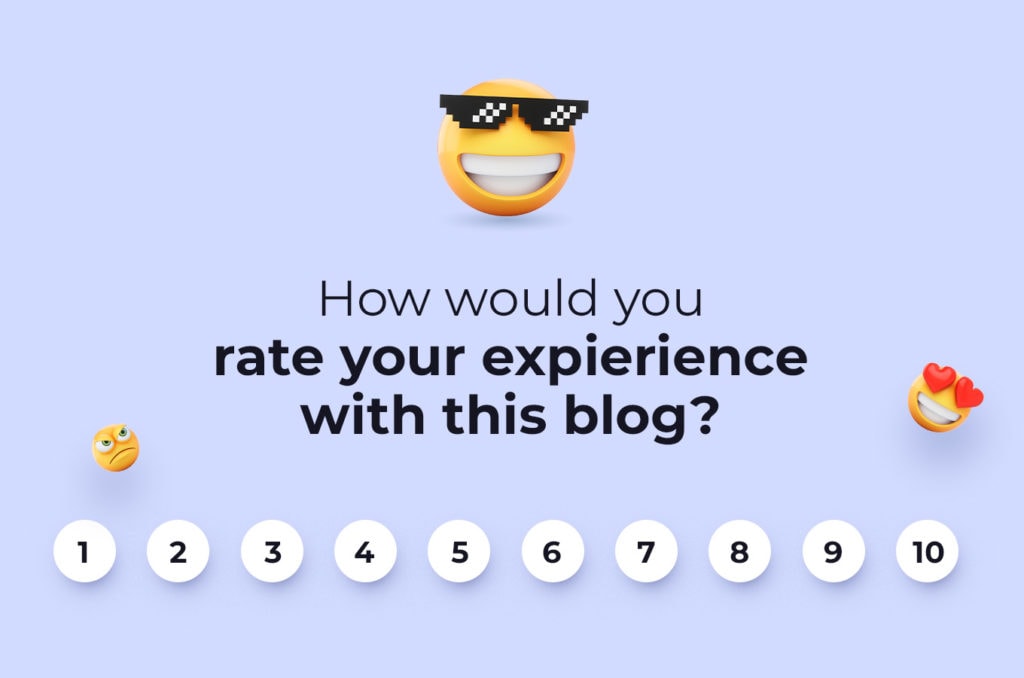
Lifetime value of a customer
Your customers should be cherished. The industry is making the move towards embracing the value that a customer may bring you during their whole engagement with your store over the short-term gains that a quick and an aggressive sale may bring.
You need to build a relationship with your customer.
As we have hinted at before, it does not always make sense. If you’re trading goods that are used on rare occasions or are expensive and bought only once a decade, your strategy should be focused on making as many sales as possible to new customers.
But for other situations, you should follow up on customers with:
- Discounts and promotions
- New items in your store
- Use seasonal occasions to remind them about your products
Remember not to spam them to death, usually an email per week is the maximum that users can handle. And if they choose to unsubscribe, design a comfortable unsubscribe flow with an optional question on the reason.
Don’t give people an excuse to leave your store
Doing everything I’ve listed increases your chances to get the most visits and purchases – but does not guarantee it. People are precarious animals that should be studied and taken care of constantly.
Hence the strong emphasis on collecting data.
The tips that we have provided are taken from a collective experience of people running online businesses, including our own – a subscription-based ad tracking platform Voluum that is both the product we deliver to thousands of happy customers and a tool for getting even more customers.
Use Voluum to gather data from your marketing efforts and data generated by your visitors on a page in one place, automate various tasks, and get a bird’s eye view into what is going on.

